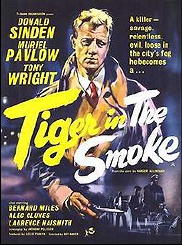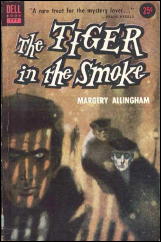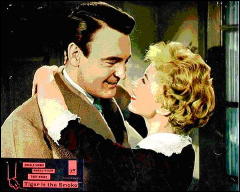Mon 12 May 2014
A Movie Review by Dan Stumpf: TIGER IN THE SMOKE (1956).
Posted by Steve under Crime Films , Reviews[8] Comments

TIGER IN THE SMOKE. J. Arthur Rank, UK, 1956. Donald Sinden, Muriel Pavlow, Tony Wright, Laurence Naismith and Beatrice Varley. Screenplay by Anthony Pelissier, from the novel by Margery Allingham. Directed by Roy Ward Baker.
First off, you should know that I watched this quite by accident. Maybe even by mistake; after reading Never Come Back, I ordered the movie supposedly made from it (Tiger by the Tail) but the dealer sent me this instead — and I’m very glad he did.
Fans of Margery Allingham (I know you’re out there; I can hear you knitting your tea-cosies) may be disappointed to find that the makers of this film dispensed completely with Albert Campion, but lovers of tricky, off-beat movie-making will be delighted by it—or at least the first half, which opens with a visual symphony worthy of Welles or Vorkapich.
It’s all set in a thick London smog, through which the characters pursue one another, appearing and vanishing at odd moments, lurking half-seen, or unseen, or maybe-seen with eerie precision. Director Baker (or maybe Cinematographer Geoffrey Unsworth deserves the credit) knows just when to generate suspense by looming a shifty shape up in the background, and just when to lose it in the mist. And there’s a remarkably fine extended business with a band of sinister performing street beggars, who wander in and out of frame in movements that look to have inspired the opening stretch of Touch of Evil.

The film itself is as intriguing plot-wise as visually: As the story opens, Meg Elgin (the delightful Muriel Pavlow) is being escorted by the police to rendezvous with a mystery man who may be her presumed-dead-in-the-war husband. Her helpful/hopeful fiancé (Donald Sinden) is also along, as the party make their way through the treacherous smog, dogged by those oddly menacing (and horribly off-key) street performers, and discover that the man who arranged the meeting is an only actor who resembles her late husband — but he’s wearing the dead man’s coat!
From here things diverge, with Sinden trailing the actor and getting caught up with the malignant cacophonists, while Pavlow and the cops try to find out how the actor got the coat. Along the way we find that a bad guy called Jack Havoc has broken jail and is out there searching for… we don’t know for what yet, but we do know it has something to do with the late husband, and Havoc is willing — even eager — to kill for whatever it is. As one of the detectives comments, “He’s pure evil.â€
Eventually Jack Havoc makes his appearance, and at this point the film falters badly. Tony Wright, who plays the part, may have been a capable actor for all I know, but he simply doesn’t project the menace we’ve been led to expect. Moreover, the fog dissipates and the visuals quiet down as the plot eventually moves off to sun-drenched Brittany and a conclusion that recalls the endings of Saboteur and North by Northwest.

There’s a surprising scene at the three-quarter mark where the heroine’s vicar father tries to reclaim Havoc’s soul, intelligently done and well-played, but it somehow misses the pathos and emotion it should have carried.
Ah well. There is, however, one surprisingly effective character: one Lucy Cash, a respectable, church-going and totally repellant creation who sucks blood out of the local poor people, and she’s played with quiet assurance by Beatrice Varley, whom you may remember from Horrors of the Black Museum. At any rate, she leads us to a minor plot twist where (SPOILER ALERT!) it turns out she’s Jack Havoc’s mum. Which makes his real name Johnny Cash, so you can see why he changed it.
Editorial Comment: David Vineyard reviewed both the book and the film nearly four years ago on this blog. Check out what he had to say here.
May 12th, 2014 at 2:45 pm
I agree with Dan about 95%. I found it interesting in the book and film that they manage to make the vicar, representing good, interesting as Havoc in his own way. The idea of a simple good man combatting Havoc’s almost charismatic evil is a powerful theme.
Allingham was always good, though I would hardly call her early books or later novels cozy, Some of the earliest Campion outings are closer to Bulldog Drummond crossed with Bertie Wooster than fair-play mystery (Allingham’s whole family wrote Boys Own Paper style adventures and it seems to have rubbed off). Some of the later novels have truly interesting premises like this one.
May 12th, 2014 at 10:14 pm
David, I read your post and could not agree more about Donald Sinden, who has been working up until recently. So, Sinden and Muriel Pavlow are both with us. Great people. I do not understand your list of detectives novels, and the inclusion of The Philadelphian, which I have here and thought quite good, and Touch of Evil, which might be the worst novel ever written by a ‘major’ writer. Thought it was like taking poison.
May 13th, 2014 at 2:00 pm
Agree pretty much with the review of the film, and David’s analysis of Allingham. In his autobiography, Roy Ward Baker complained that the casting of Wright had been pretty much forced on him by the producer. He would have preferred someone like Stanley Baker–someone with presence and charisma, who could be convincingly evil but charming with it. It’s a shame, as the scene with the canon is electrifying in the novel. Laurence Naismith was a superb actor, and you can imagine what the scene would have played like with the right actor opposite him.
May 13th, 2014 at 2:11 pm
Sorry, meant Touch of Danger not Touch of Evil. James Jones failed exploration into mystery.
May 13th, 2014 at 3:31 pm
Roy Ward Baker did an autobiography?
May 13th, 2014 at 4:08 pm
Barry.
I like Touch of Danger, but I admit freely quite a few people felt the way you do about it.
While The Philadelphian is a mainstream novel made into a mainstream film it does turn on a murder and a decent bit of detective work by the main character and it is written by mystery writer Richard Powell. It’s one of those Hubin would probably list with an * as associational.
On any list like that I like to throw in a few books to draw comments and even argument because there are books that clearly blur the line. Where do you put books like It Happened in Boston?, The Eighth Circle, and some recent others that are as much straight novels as genre?
I think a good list of that sort should stretch limits and inspire disagreement. In a more scholarly and serious forum I might not have included either book.
Bradstreet,
I agree Baker would have been superb as Havoc. Wright isn’t bad, but Havoc is a force of nature and Wright just isn’t.
May 13th, 2014 at 6:16 pm
Dan: THE DIRECTOR’S CUT: A MEMOIR OF SIXTY YEARS IN FILM AND TELEVISION by ROY WARD BAKER. It’s a very interesting read. The problem is that the publishers (Marcus & Hearn) are fairly specialist, so the print run was not huge. That said, I’ve seen a number of copies selling for about £10 on Amazon.
June 23rd, 2023 at 9:07 am
The interior church scenes were filmed in St Mary Abchurch, City of London